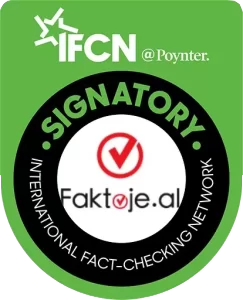The tension created in the northern part of Mitrovica after the armed attack on the Banjskë Monastery once again revived the propagandistic rhetoric that fuels ethnic hatred between Albanians and Serbs. Researchers from Kosovo and Serbia view the escalation of the narrative to instill fear and tensions within the population.
Serbian Rhetoric
Since September 24th, when 30 armed individuals barricaded themselves in the Banjskë Monastery and exchanged gunfire with the Kosovo Police, resulting in the killing of officer Afrim Bunjaku, political rhetoric inciting ethnic hatred began to emerge in Serbia.
Even before the Banjskë incident concluded, Serbian President Aleksandar Vučić made claims that the attack was carried out by Serbs living in the northern part of Mitrovica as a result of the “terror exercised by Albin Kurti against them”. Despite the quick refutation of this claim by Milan Radojić, the Vice President of the Serbian List, who accepted blame for organizing the attack, Vučić did not back down.
There are three main theses put forward by Vučić against Kosovo, specifically targeting Prime Minister Albin Kurti.
The first and most repeated narrative is that “Albin Kurti seeks war”, followed by the thesis that “Serbia does not desire war but struggles to maintain fragile peace” and the final thesis, also echoed recently by Russia, that “Kurti is conducting a brutal ethnic cleansing against Serbs in Kosovo”.
The Spread of Hate Speech
Following the attack on Banjskë, the accusations made by Vučić, apart from targeting Kosovo’s Prime Minister Kurti, also singled out the Kosovo Police forces.
Vučić attempted to cast doubt on the involvement of EULEX, the EU Mission in the Kosovo Police action in Banjskë, but was publicly refuted by EULEX.
Despite the release of information that refutes the claims made in Belgrade, their dissemination by other Serbian politicians continues.
Serbian Domestic Politics
Vučić’s accusations were reiterated by the Prime Minister of Serbia, Ana Brnabić. “The terror of Albin Kurti against the Serbs in Kosovo and Metohi continues, entirely in line with what we have been saying and what the President of Serbia, Aleksandar Vučić, has been saying for months, terror and mistreatment of Serbs in Kosovo and Metohi,”, said Brnabiç emphasizing that Serbia was in constant contact with KFOR and the international community.

In fact, KFOR has continuously announced its presence in Banjskë and ongoing coordination with Serbia and Kosovo..
The KFOR mission in Kosovo consists of NATO peacekeeping troops who have been contributing to maintaining a secure environment in Kosovo and ensuring freedom of movement for all since 1999. This certainly contradicts the existence of “continuous terror against Serbs in northern Kosovo,” as claimed by the Serbian side.
NATO Secretary-General Jens Stoltenberg’s statement on September 29th reiterated the ongoing international monitoring of the situation in Kosovo.
“NATO’s KFOR mission maintains a visible and agile presence across Kosovo. We will always take all necessary actions to maintain a safe and secure environment and freedom of movement for all people living in Kosovo. We do so impartially and in line with our UN mandate.”
KFOR continues to coordinate closely with all relevant stakeholders in Belgrade and Pristina, as well as EU Rule of Law Mission (EULEX), the OSCE, the UN Mission to Kosovo, and the diplomatic community.” – Statement by the Secretary-General on the Situation in Kosovo.
At the same time, EULEX informed Faktoje that not only has it been in continuous coordination with the Kosovo Police during the action in Banjskë, but this cooperation is ongoing.
“The Mission also monitored and is continuing to monitor, activities carried by the Kosovo authorities in relation to the attack, such as investigations, seizures and searches.” – EULEX for Faktoje, 28 September 2023.
Serbia’s allies
Despite these facts, Vučić’s rhetoric continues to be echoed by his partners beyond borders.
Ivan Stoikovic, the leader of the Serbian Democratic Party and the sole representative of Serbs in the North Macedonia parliament said that Kurti hates Serbs and practices terror against the Serbian community in Kosovo.
This repeated accusation, which is never accompanied by arguments or facts, is fully supported by Serbia’s ally in the East, Russia.
A statement from the Russian Foreign Ministry one day after the Banjskë attack – a time when the source of the attack had not yet been confirmed despite suspicions of Serbian involvement – was echoed by the ministry’s representative, Maria Zakharova. She reiterated the accusations that had been heard the day before from President Vučić.
“There is no doubt that yesterday’s bloodshed is a direct and immediate consequence of the so-called ‘Prime Minister’ Kurti’s course to incite conflict and cleanse the region’s territory of Serbs.” – The Russian Foreign Ministry declared on September 25, 2023.
The preservation of peace and the Serbian and Russian “threat.”
Vučić’s claims regarding Pristina’s intentions and Serbia’s role in “maintaining fragile peace” in Kosovo represent one of the most contradictory aspects of Serbian politics. This is because Vučić’s own statements seem to contradict each other from day to day.
On the day of the events in Banjskë, Vučić declared that Serbia would never recognize Kosovo’s independence, even if they “kill all” the Serbs. Shortly after Vučić stated that Serbia is willing to continue the EU and US-mediated dialogue for normalizing relations with Kosovo.
In another interview given on September 28th to Reuters, Vučić stated that an attack like the one in Banjskë was of no interest to Belgrade, and that “Serbia does not want war.” Meanwhile, one day after this statement, the United States asked Serbia to withdraw its military troops from the border with Kosovo, as they had observed an “unprecedented increase in the Serbian military presence”.
Vučić denied the U.S. claims of troop deployment near the Kosovo border during an interview with CNN on October 2nd.
When asked why the Serbian government moved more troops to the border, Vučić explained that the Serbian army “monitors the situation on the ground, and they move our forces in a way they believe might be more useful, and they have their operations and everything else, but I have not signed any alarms for our army.” – said Vuçiç.
This denial of troop buildup was also articulated by Serbia’s Ambassador to the United States, Marko Đurić.
“As for the supposed Serbian gathering, the only thing that exists is the withdrawal of forces that have been there for years – from 7,500 to the historic minimum of 4,000. Because we are the responsible party, desiring peace and attempting to avoid further bloodshed..” – wrote Đurić on the social media platform Twitter.
On the same day, October 2nd, the Serbian Minister of Defense, Millosh Vučević, was reported to have said se “that if the Serbian Armed Forces receive an order from the President of Serbia as the Commander-in-Chief to enter Kosovo’s territory, the Serbian Armed Forces will carry out such a task efficiently, professionally, and successfully.””.
The day after this statement, on October 3, the Coordinator for Strategic Communications John Kirby declared from the White House podium that Serbian troops had begun to withdraw from the border with Kosovo.
Reiterating Vučić’s political thesis that the escalation of tension can only be prevented by establishing the Association of Serbian Municipalities, Russia, through its Foreign Ministry, also spoke of ‘playing with fire that endangers the Balkans.’.
Reiterating Vučić’s political thesis that the outbreak of tension can only be prevented by the creation of the Association of Serbian Municipalities, Russia, through its Foreign Ministry, also spoke of ‘playing with fire that endangers the Balkans.’.
“His [Kurti’s] efforts to create Western pressure on Serbian leadership by escalating the situation to force Belgrade to recognize the ‘independence’ of Kosovo are an ongoing game with fire, which, as we see, is very costly and brings the entire Balkan region to a dangerous threshold.” – wrote the Russian Foreign Ministry.
The Purpose and Effect of Narratives
“Instilling fear and tensions” – this are the purpose of such narratives, according to Nikola Petroviç, the head of the Center for International Relations and Sustainable Development (ISAC Foundation) in Serbia.
“The reasons and purpose are quite simple: these [statements] create a smokescreen for the Serbian authorities and their actions. Any criticism of Vučić is met with the claim that it is an attack on Serbia because Vučić is the one who defends Serbia, and it cannot be his fault, as Kurti is to blame for everything.” – Petrović said to Faktoje.

Nikola Petroviç, ISAC Foundation

Fitim Gashi, journalist, S’bunker
Journalist Fitim Gashi, who is also the project manager for Countering Disinformation in the Western Balkans in Kosovo’s online media platform S’bunker refers to the statements of Serbian politicians as incitement to “ethnic division through the narrative that Serbs cannot coexist with Albanians within the state of Kosovo.”
Gashi argues that such statements have a more significant impact on the Serbian population, especially those in northern Kosovo, as they primarily consume news from Serbian media outlets close to Vučić’s party, which present a different narrative about the state of Kosovo or the decisions being attempted in northern Kosovo.
“In the case of Banjskë, the attempt to justify the attack, which was widely condemned even by the international community, with something that has not been confirmed thus far – namely the persecution of Serbs – is done with the aim of increasing the revolt and resistance of citizens in that area against the Kosovo government and authorities.” – Gashi explains.
According to Serbian researcher Nikola Petrović, “the majority of the population sees these statements as exaggerated, but they are still worried that scenarios like ethnic cleansing of Serbs in Kosovo are possible. This is further fueled by several other actors in Kosovo,” he notes.
Emphasizing that such narratives are not something new between Kosovo and Serbia, Petković notes that the “continuous and frequent repetition of the same claims makes it easy to assume that most of the population either believes [Vučić] or is partially convinced that Kurti is an enemy of Serbia and the Serbs.
Journalist Fitim Gashi views situations like the one on September 24th in Banjskë as inciters of ethnic hatred. “We have seen such narratives for years through which Serbian officials attempt to create an anti-government sentiment. The unfortunate part is that Belgrade has continuously instrumentalized Serbs in the north to achieve political goals,” Gashi explains.
Conclusion
The terrorist attack in Banjskë revived disinformation narratives that fuel ethnic hatred between Albanians and Serbs, primarily articulated by politicians in Serbia. Some of the claims raised by President Aleksandar Vučić have already been refuted, but the perpetuation of misleading narratives still has an impact on the public in Serbia and Kosovo.
* This article was produced as part of the regional initiative the Center for Countering Disinformation in the Western Balkans.






